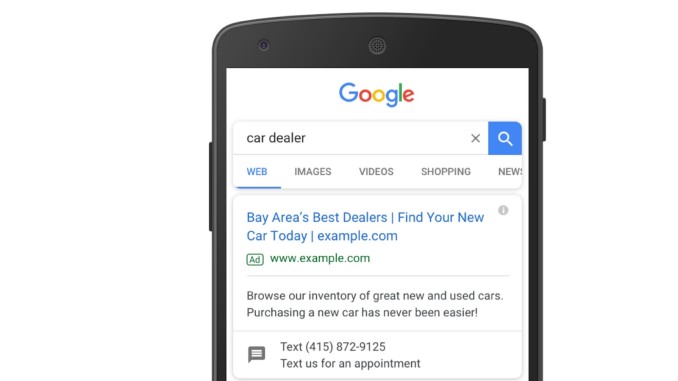
65% of consumers say they’d consider using messaging to connect with a business to complete tasks like getting information about a product or service, or to schedule an in-person appointment.1 That’s why we introduced click-to-message ads in late 2016 to give advertisers a new and easier way to engage with consumers. Message reporting will roll out over the next few weeks to help advertisers in the U.S., Canada, U.K., France, Brazil and Australia analyze and improve the performance of your click-to-message ads. Example of a click-to-message adMessage reporting offers new performance insights including:Chat rate – how often users start a conversation with you (“Chats”) after seeing your message extension (“Message impressions”).Example: A law firm discovers that consumers prefer messaging over calls when asking questions about real estate law. To improve the chat rate, it tailors its extension text to be more relevant by replacing the generic, “Text us to learn more” with “Text a real estate lawyer now.” It also enhances its message text to better reflect the user’s voice and how they’d really speak. It changes, “I’d like to know more, please text me back.” to “Hi, I’m looking for a real estate lawyer. Please reply back with more information.”Chat start time – the timestamp for when a user sends you a message to initiate a conversation. Use this insight to help schedule your message extensions.Example: A travel tour company sees that its chat volume peaks at noon when people are sending the most booking requests. This also coincides with when their “Time to first reply” takes the longest. As a result, they add an extra sales representative to assist customers more quickly.Messages – the total number of messages exchanged between you and a user within a single chat. Use this insight to evaluate which campaigns are driving the longest or most in-depth conversations compared to the average.Example: A furniture retailer sees that in one campaign, chats tend to last for fifteen messages, which is more than double the average. It discovers that users are actually dropping off once a sales representative requests payment information. Using this insight, it decides to give users the option of transferring to a phone call or web form to complete the transaction.“With message extensions, we can deliver a more personal, two-way conversation to customers on mobile when they’re going through the complex task of finding legal services. New message reporting gives us great insight into which keywords are producing engaged conversations. We can use this to optimize our extension and message text, and to make better bidding decisions. Most messaging threads result in a qualified lead for a law firm. Since our chat rate is more than 2x the conversion rate for the online lead form, routing people through messaging is ideal to help increase lead volume.” – Maisie Harris, Chief Marketing Officer at LeadRival “One of our key differentiating factors is allowing customers to work directly with a stylist, including via text messaging from our Google search ads. Our customers are busy professionals who need quick answers, and frequently don’t have the time to navigate a website. Using message extensions, we can offer fast assistance when they’re looking for a style recommendation or opinion on fit, and can easily share images and links. Now, message reporting will help us analyze which parts of our campaigns are driving the most in-depth, valuable conversations with stylists, and where we can improve performance.” – Michaella Kurdziel, Director of Experience Excellence & Learning at MM.LaFleur Visit the Help Center to learn the full range of insights available with message reporting and how you can use them to optimize your click-to-message performance. Also read our best practices for driving more valuable customer conversations with messaging.Posted by Hareesh Nagarajan, Product Manager, Mobile Search Ads1. Google Consumer Surveys, US, Canada, UK, Australia, October 2016, Base: Respondents who own a smartphone and use it to access the Internet (n = 1,036 in US, n = 1,032 in UK, n = 489 in Canada, n = 485 in Australia).
Source: Google Inside Adwords
Link: Message reporting delivers new performance insights for click-to-message ads



Leave a Reply